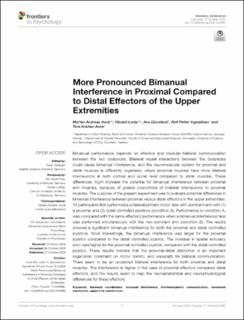| dc.contributor.author | Aune, Morten Andreas | |
| dc.contributor.author | Lorås, Håvard | |
| dc.contributor.author | Ane, Djuvsland | |
| dc.contributor.author | Ingvaldsen, Rolf Petter | |
| dc.contributor.author | Aune, Tore Kristian | |
| dc.date.accessioned | 2021-02-03T12:55:43Z | |
| dc.date.available | 2021-02-03T12:55:43Z | |
| dc.date.created | 2020-10-06T12:58:47Z | |
| dc.date.issued | 2020 | |
| dc.identifier.citation | Aune, M. A., Lorås, H., Ane, D., Ingvaldsen, R. P. & Aune, T. K. (2020). More pronounced bimanual interference in proximal compared to distal effectors of the upper extremities. Frontiers in Psychology, 11: 544990. doi: | en_US |
| dc.identifier.issn | 1664-1078 | |
| dc.identifier.uri | https://hdl.handle.net/11250/2726003 | |
| dc.description.abstract | Bimanual performance depends on effective and modular bilateral communication between the two bodysides. Bilateral neural interactions between the bodysides could cause bimanual interference, and the neuromuscular system for proximal and distal muscles is differently organized, where proximal muscles have more bilateral interneurons at both cortical and spinal level compared to distal muscles. These differences might increase the potential for bimanual interference between proximal arm muscles, because of greater proportions of bilateral interneurons to proximal muscles. The purpose of the present experiment was to evaluate potential differences in bimanual interference between proximal versus distal effectors in the upper extremities. 14 participants first performed a unilateral primary motor task with dominant arm with (1) a proximal and (2) distal controlled joysticks (condition A). Performance in condition A, was compared with the same effector’s performance when a bimanual interference task was performed simultaneously with the non-dominant arm (condition B). The results showed a significant bimanual interference for both the proximal and distal controlled joysticks. Most interestingly, the bimanual interference was larger for the proximal joystick compared to the distal controlled joystick. The increase in spatial accuracy error was higher for the proximal controlled joystick, compared with the distal controlled joystick. These results indicate that the proximal-distal distinction is an important organismic constraint on motor control, and especially for bilateral communication. There seem to be an undesired bilateral interference for both proximal and distal muscles. The interference is higher in the case of proximal effectors compared distal effectors, and the results seem to map the neuroanatomical and neurophysiological differences for these effectors. | en_US |
| dc.language.iso | eng | en_US |
| dc.publisher | Frontiers | en_US |
| dc.rights | Navngivelse 4.0 Internasjonal | * |
| dc.rights.uri | http://creativecommons.org/licenses/by/4.0/deed.no | * |
| dc.title | More pronounced bimanual interference in proximal compared to distal effectors of the upper extremities | en_US |
| dc.type | Peer reviewed | en_US |
| dc.type | Journal article | en_US |
| dc.description.version | publishedVersion | en_US |
| dc.rights.holder | © 2020 The Author(s) | en_US |
| dc.subject.nsi | VDP::Medisinske Fag: 700::Idrettsmedisinske fag: 850 | en_US |
| dc.subject.nsi | VDP::Samfunnsvitenskap: 200::Psykologi: 260 | en_US |
| dc.source.volume | 11 | en_US |
| dc.source.journal | Frontiers in Psychology | en_US |
| dc.identifier.doi | doi: 10.3389/fpsyg.2020.544990 | |
| dc.identifier.cristin | 1837599 | |
| dc.source.articlenumber | 544990 | en_US |

